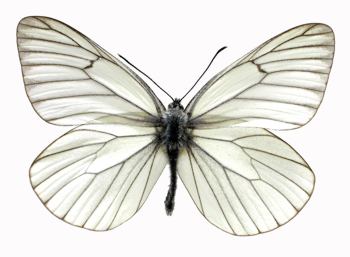Pests
Aporia crataegi Linnaeus- Black-Veined White.
Taxonomic position.
Class Insecta, order Lepidoptera, superfamily Papilionoidea, family Pieridae, subfamily Pierinae, genus Aporia. In the former USSR the subspecies A. crataegi tianschanica Ruehl from Central Asia and southeastern Kazakhstan, A. c. adherbal Fruhstorfer from southern Sakhalin and southern Kurils and 3 subspecies from highlands of Armenia, Pamirs and Kopetdag are known in addition to nominative subspecies. Seven more subspecies have been described from Siberia and the Far East, being most likely variations of the subspecies A. c. crataegi.Biological group.
Oligophagous pests of fruit crops.Morphology and biology.
Wings monochromatic, white, with black veins; wingspan 60-70 mm; a thin black line passes along margins of wings. Scaly cover of female wings minimal; therefore, they are translucent. Male wings without scales at margins only. Thorax and abdomen dark, covered with light hairs. Average fecundity is 200 eggs, maximum 500. Eggs yellowish, lengthened, barrel-shaped, with blunt top and longitudinal ribbing, laid in batches on upper and lower sides of leaves. Duration of egg development is 10 to 20 days. Caterpillar is brownish-gray, with dark head, its brown body having 2 wide reddish dorsal stripes and rather thin pubescence of fine light hairs. In spring the caterpillars resume their activity during swelling and blooming of buds and gnaw out their contents. Later they skeletonize leaves, leaving only veins. Caterpillars of young instars live and eat together, caterpillars of 5th instar live individually. Pupation occurs at the end of spring or at the beginning of summer on branches and on trunks of host trees. Pupae are bright yellow, with black spots and dots, attached to substratum with the help of silk thread, keeping head upward. The pupal phase lasts about 2 weeks. Caterpillars of 2-3 instars winter in niduses compiled of several leaves fastened with silk thread, 10-70 individuals in a nidus. Niduses are strongly attached by the thread to branches, hanging on trees the entire winter.Distribution.
Occurs in Europe, Algeria, Morocco, Tunisia, Middle East, Mongolia, China, Japan, Korea, the Caucasus and Transcaucasia, in Baltic States, Ukraine, Moldova, mountain areas of Central Asia and Kazakhstan. In Russia it is distributed throughout the entire European part, in Siberia and the Far East (Amur, Sakhalin and Kamchatka Regions, Khabarovsk and Primorskii Territories, southern Kurils).Ecology.
Everywhere monovoltine. Butterflies fly in May-July depending on latitude and altitude of a district. Flight lasts about one month. Before laying eggs the butterflies need additional feeding on flower nectar and water. The pest distribution is limited by a combination of high temperatures and lack of moisture.Economic significance.
Caterpillars damage buds and leaves of apple, pear, plum trees, cherries, sweet cherries, quince, cherry plum, sloe trees, apricot, peach, hawthorn, shadberry, mountain ashes, and also wild-growing arboreal rosaceous plants. They are also recorded on grapes, walnut, and in Siberia and the Far East on blueberry. During mass reproductions the caterpillars can strip trees completely bare. The highest number of Black-Veined White caterpillars in steppe and forest-steppe is reported in the area of steady precipitation of more than 70 mm in June and July, or in the areas where annual the amount of precipitation is more than 700 mm. The pest was economically significant in industrial gardens until the middle 20th century. Due to increased levels of agronomy and regular treatments against codling moth and other harmful lepidopterans it has lost its significance as an especially dangerous pest. Control measures include collecting and burning winter niduses during the autumn and winter periods, attraction of insectivorous birds in gardens and treatments with insecticides in the years of outbreaks.
Reference citations.
Belyaev E.A. 1988. Pieridae. In: Belyaev E.A. et al., eds. Butterflies - pests of agriculture in the Far East. Keys. Vladivostok: Biology and Soil Institute, DO AN SSSR: 217-262 (in Russian).D.yakonov A.M. & Kozhanchikov I.V. 1949. Lepidoptera. In: Pavlovskii E.N. & Shtakelberg A.A., eds. Pest Animals of Middle Asia (handbook). Moscow & Leningrad: AN SSSR: 22-43 (in Russian).
Daricheva M.V. 1988. Fauna and ecology of Pieridae (Lepidoptera) of Turkmenistan. Izvestiya AN Turkm.SSR. Seriya biol. nauk. Ashkhabad: Ylym, N 2: 61-68. (in Russian).
Korshunov Yu.P. 2002. Ropalocerous Lepidoptraens of northern asiaa. Moscow: KMK, 424 pp. (in Russian).
L.vovskii A.L. 1999. Pieridae. In: Kuznetsov V.I., ed. Insects and mites - pests of agricultural plants. V. 3(2). Lepidoptera. St.Petersburg: Nauka: 233-242. (in Russian).
Nekrutenko Yu.P. 1974. Pieridae. In: Vasil.ev V.P., ed. Pests of agricultural crops and forest plantations. V.2. Arthropods. Kiev: Urozhai: 411-414. (in Russian).
Prokof.ev M.A. 1987. Control of orchard pests in Siberia. Moscow: Rossel.khozizdat, 239 pp. (in Russian).
Vasil'ev V.P., Livshits I.Z. 1984. Pests of fruit crops. Moscow: Kolos, 399 pp. (in Russian).


